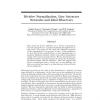Free Online Productivity Tools
i2Speak
i2Symbol
i2OCR
iTex2Img
iWeb2Print
iWeb2Shot
i2Type
iPdf2Split
iPdf2Merge
i2Bopomofo
i2Arabic
i2Style
i2Image
i2PDF
iLatex2Rtf
Sci2ools
NIPS
1998
1998
Divisive Normalization, Line Attractor Networks and Ideal Observers
Gain control by divisive inhibition, a.k.a. divisive normalization, has been proposed to be a general mechanism throughout the visual cortex. We explore in this study the statistical properties of this normalization in the presence of noise. Using simulations, we show that divisive normalization is a close approximation to a maximum likelihood estimator, which, in the context of population coding, is the same as an ideal observer. We also demonstrate analytically that this is a general property of a large class of nonlinear recurrent networks with line attractors. Our work suggests that divisive normalization plays a critical role in noise ltering, and that every cortical layer may be an ideal observer of the activity in the preceding layer. Information processing in the cortex is often formalized as a sequence of a linear stages followed by a nonlinearity. In the visual cortex, the nonlinearity is best described by squaring combined with a divisive pooling of local activities. The di...
Divisive Normalization | Maximum Likelihood | Maximum Likelihood Estimation | NIPS 1998 | NIPS 2007 |
| Added | 01 Nov 2010 |
| Updated | 01 Nov 2010 |
| Type | Conference |
| Year | 1998 |
| Where | NIPS |
| Authors | Sophie Deneve, Alexandre Pouget, Peter E. Latham |
Comments (0)

